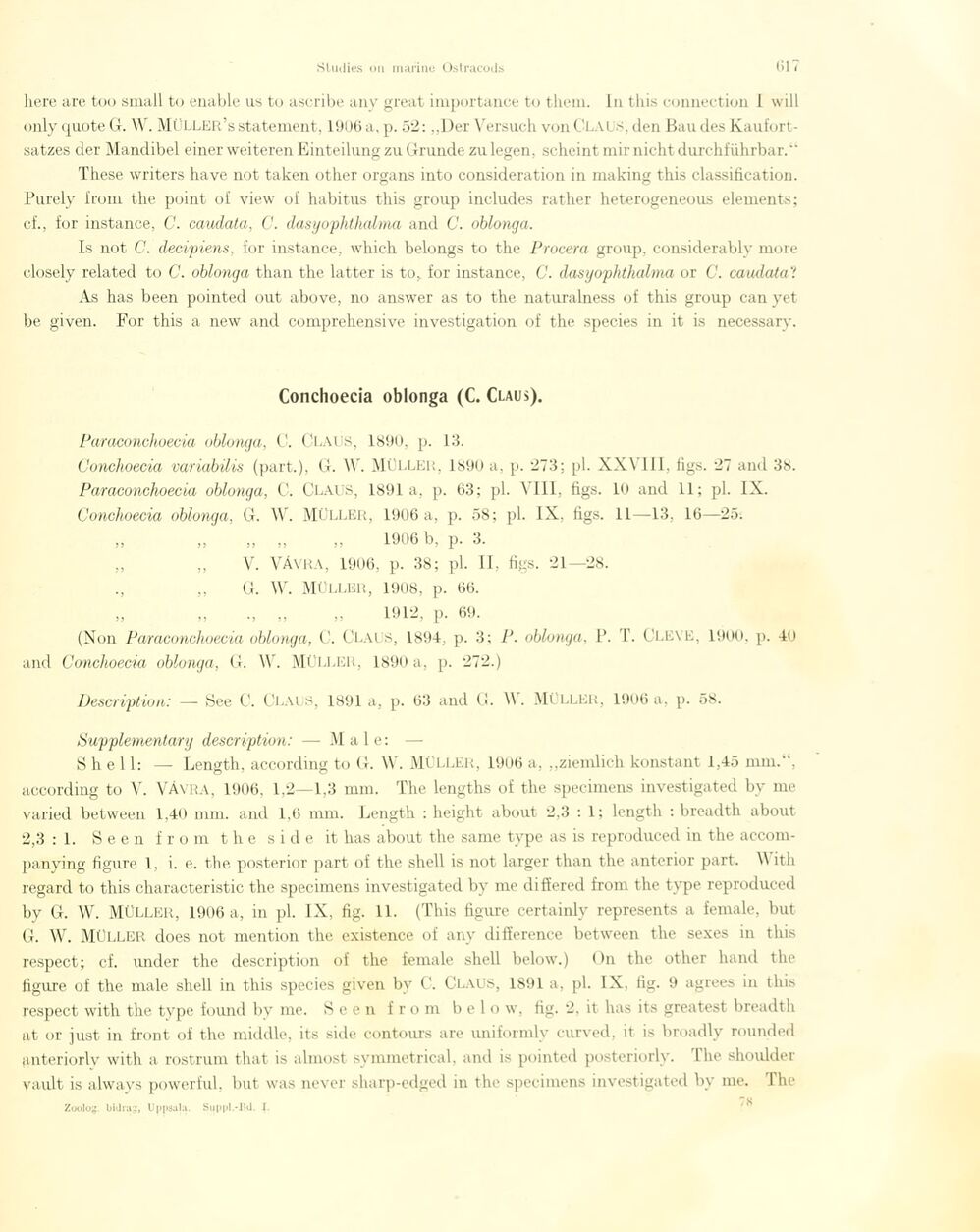
Full resolution (JPEG) - On this page / på denna sida - Sidor ...

<< prev. page << föreg. sida << >> nästa sida >> next page >>
Below is the raw OCR text
from the above scanned image.
Do you see an error? Proofread the page now!
Här nedan syns maskintolkade texten från faksimilbilden ovan.
Ser du något fel? Korrekturläs sidan nu!
This page has never been proofread. / Denna sida har aldrig korrekturlästs.
here are too small to enable us to ascribe any great importance to thern. In this connection 1 will
only quote G. V. MüLLER’s statement, 1906 a, p. 52: „Der Versuch von Clal s. den Bau des
Kaufortsatzes der Mandibel einer weiteren Einteilung zvi Grunde zu legen, scheint mir nicht durchführbar.”
These writers have not taken other organs into considération in making this classification.
Purely from the point of view of habitus this group includes rather heterogeneous elements;
cf., for instance, C. caudata, C. dasyophthalma and C. oblonga.
Is not C. decipiens, for instance, which belongs to the Procera group, considérable more
closely related to C. oblonga than the latter is to, for instance, C. dasyophthalma or C. caudata’!
As has been pointed out above, no answer as to the naturalness of this group can yet
be given. For this a new and comprehensive investigation of the species in it is necessary.
Conchoecia oblonga (C. Claus).
Paraconchoecia oblonga, C. CLAUS, 1890, p. 13.
Conchoecia variabilis (part.), G. \V. MULLER, 1890 a, p. 273; pl. XXVIII, figs. 27 and 38.
Paraconchoecia oblonga, C. CLAUS, 1891a, p. 63; pl. VIII, figs. 10 and 11; pl. IX.
Conchoecia oblonga, G. W. MÜLLER, 1906 a, p. 58; pl. IX, figs. 11—13, 16—25.
,, ,, ,, ,, ,, 1906 b, p. 3.
,, ,, V. VÂVRA, 1906, p. 38; pl. II, figs. 21—28.
G. W. Müller, 1908, p. 66.
„ „ ., „ „ 1912, p. 69.
(Non Paraconchoecia oblonga, C. Claus, 1894, p. 3; P. oblonga, P. T. Cleye, 1900, p. 40
and Conchoecia oblonga, G. V. MULLER, 1890 a, p. 272.)
Description: — See C. Claus, 1891 a, p. 63 and G. W . MULLER, 1906 a, p. 58.
Supplementary description: — Male:
Shell: — Length. according to G. W. MÜLLER, 1906 a, „ziemlich konstant 1,45 mm.“,
according to V. Vâyra, 1906. 1,2—1,3 mm. The lengths of the specimens investigated by me
varied between 1,40 mm. and 1.6 mm. Length : height about 2,3 : 1; length : breadth about
2,3 : 1. Seen from the side it has about the same type as is reproduced in the
accom-panying figure 1, i. e. the posterior part of the shell is not larger than the anterior part. M ith
regard to this characteristic the specimens investigated by me differed from the type reproduced
by G. W. Müller, 1906 a, in pl. IX, fig. 11. (This figure certainly represents a female, but
G. W. Müller does not mention the existence of any difference between the sexes in this
respect; cf. under the description of the female shell below.) On the other hand the
figure of the male shell in this species given by C. CLAUS, 1891 a. pl. IX, fig. 9 agrees in this
respect with the type fourni by me. Seen fro m b e 1 o w, fig. 2. it has its greatest breadth
at or just in front of the middle, its side contours are uniformly eurved, it is broadly rounded
anteriorlv with a rostrum that is almost symmetrical, and is pointed posteriorly. The shoulder
vault is always powerful, but was never sharp-edged in the specimens investigated by me. The
Zoolog, bidrag, Uppsala. Suppl.-Ud. I.
<< prev. page << föreg. sida << >> nästa sida >> next page >>